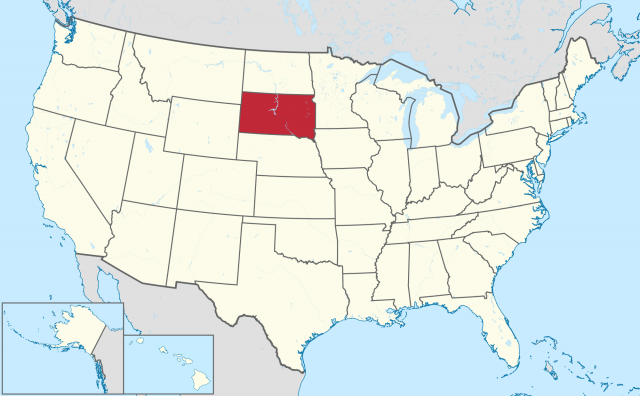South Dakota
SOUTH DAKOTA, IN THE American Midwest, is the 17th largest state at 77,121 square mi (199,742 square km), but is small in population (just 754,844 people ranking it as 46th largest in population). Accordingly, South Dakota is a very sparsely populated state, with just under 10 people per square mile.
The landscape of South Dakota varies from mainly rolling hills and plains in the east to drier and more rugged terrain in the west. In terms of both the PHYSICAL GEOGRAPHY and the CULTURAL GEOGRAPHY, South Dakotans use the Missouri River as the major divide for the state, referring to the West River and East River portions of the state. This colloquial division roughly corresponds with a western dry continental climate fitting the Great Plains and an eastern humid continental climate of an agricultural interior. South Dakota is bordered to the north by NORTH DAKOTA, to the south by NEBRASKA, to the west by MONTANA and WYOMING, and to the east by MINNESOTA and IOWA.

The western ruggedness of South Dakota is witnessed in fantastic form at the Badlands, a stunning region where intricately colored and shaped rock formations were created from erosion over the ages. Nearby the ruggedness reaches its apex at Mount Harney (7,242 ft or 2,207 m) in the Black Hills, a lushly forested area along the Wyoming border.
In addition to the forests that gave it the name Black Hills, the region features a number of interesting physical landscape features: sharp slopes such as Spearfish Canyon, erosional spires or pinnacles known as The Needles, and limestone caverns such as Wind Cave and Jewel Cave. Besides their scenic beauty, the Black Hills hold a rich history of gold mining, gambling, grazing buffalo, and colorful figures such as Wild Bill Hickock and Calamity Jane in the town of Deadwood. While the Black Hills, featuring Mount Rushmore and the Badlands, do get many tourists, the urban focal point is Rapid City (population 59,607). Otherwise the region is mainly a mix of small towns, farms and ranches, and impoverished Indian reservations.
On the whole, South Dakota experiences a climate of seasonal extremes. Winter brings annually varying amounts of snow but intensely cold temperatures. For the months of December, January, and February temperatures below zero are not uncommon. Nighttime temperatures can reach -30 degrees F (-34 degrees C) and even daytime wind-chill factors may present health risks for those not properly dressed for the cold. After a typically brief and wet spring season, summers in South Dakota bring heat and sunshine. Usual summer days have high temperatures reaching 70 to 90 degrees F (21 to 32 degrees C), but several times each summer the heat will pass 100 degrees F (37 degrees C ). South Dakota residents often cite the pleasant and dry falls as their favorite time of the year. Both winter and summer offer extreme storms. Winter blizzards often close highways and schools. Summer thunderstorms are spectacular and common, with some of these storms spawning tornadoes.
POPULATION GEOGRAPHY
Although the rich physical geography of the western half of the state leaves eastern South Dakota with its modest hills and plains, a majority of the human activity takes place in the east. Most of the state's small population resides in the east, especially as urban nodes along the interstate highway system. The I-29 corridor features the state's largest city Sioux Falls (123,975) as well as Aberdeen (24,658), Watertown (20,237), Brookings (18,504) and Yankton (13,528). In fact, a majority of the state's population lives in this narrow corridor within 80 km (50 mi) of the state's eastern border.
Blessed with rich chernozem soils, the eastern half of the state features successful corporate and family farms. Agriculture is the largest segment of South Dakota's economy. The state typically leads the country in the production of oats and rye but also produces considerable yields of corn, wheat, and soybeans. The towns and cities of South Dakota, principally Sioux Falls, feature light manufacturing and increasing service and financial sector employment, bolstered by tourism.